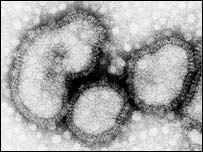| (insert your NIE or newspaper logo here) |
Weekly Online LessonOnline Lesson ArchiveGrade Level: 6-9
|
Fighting Influenza
 The Centers for Disease Control and Prevention announced on Tuesday, October 5, 2004, that half of America's expected flu vaccine supply was likely contaminated and unusable. A week later, it was confirmed that none of the vaccinations could be salvaged.
The Centers for Disease Control and Prevention announced on Tuesday, October 5, 2004, that half of America's expected flu vaccine supply was likely contaminated and unusable. A week later, it was confirmed that none of the vaccinations could be salvaged.
In August, one of the three flu vaccine suppliers, the Chiron Corporation -- an American company based in the UK -- discovered that some of its supply had become contaminated by bacteria that can cause blood poisoning and infections when injected. With Chiron now shut down and under investigation, no one can produce enough of an immediate supply to meet the expected demand.
So, what was supposed to be a supply of 100 million doses is now only about 57 million. During last year's flu season, health care workers gave out about 87 million shots.
In response to the shortage, people have been standing in line for hours at clinics, hospitals and supermarket pharmacies to get their vaccinations, where staff members have been directed to give shots only to those in high-risk groups. These groups include the elderly, the chronically ill, and the very young.
But even with targeting only these groups, there is still not enough vaccine for everyone.
Many people are worried, because influenza kills thousands of people every year -- about 36,000 in the United States alone. For those who do survive, many will have lost time at work and face the added expense of medical treatment.
Getting a flu shot is one way to help protect you from the flu, but there are other ways, too. So in this week's lesson, you'll learn how exactly influenza works and how you can keep your body healthy through flu season -- or at least help it recover from a flu attack as quickly as possible. You'll also uncover the history of America's deadliest bout with influenza, which killed 50,000 people in just one month.
Flu Basics
 Let's start with the basics of Influenza: The Virus, The Disease, and How to Protect Yourself. As you browse through the pages, click on underlined links to view related graphics and animations.
Let's start with the basics of Influenza: The Virus, The Disease, and How to Protect Yourself. As you browse through the pages, click on underlined links to view related graphics and animations.
First, check out What is Influenza?, reading about the Facts, as well as the Symptoms and Complications.
(Note: The site says that about 20,000 Americans die annually from flu. The CDC notes that the average annual death rate between 1990 and 1999 was 36,000.)
Where does the flu rank in the top 10 leading causes of death in the U.S.? How can you explain the cyclical nature of the Weekly Pneumonia and Influenza Mortality Chart? What is the incubation period? How exactly can the flu lead to pneumonia?
What are some of the flu's Common Symptoms? Who Should Get the Vaccine? Who Should Not Get the Vaccine? Make sure to also find out What To Do If You Develop Influenza.
 So far we've explored how we feel and what to do when we have the flu, now let's look closer at The Influenza Virus itself. How are viruses different from bacteria? How many types of flu virus are there?
So far we've explored how we feel and what to do when we have the flu, now let's look closer at The Influenza Virus itself. How are viruses different from bacteria? How many types of flu virus are there?
Keep browsing through this section to look at The Virus Structure, and also how viruses have gotten good at Evading Immunity through Shift and Drift. Who participates in Global Virus Surveillance?
In the next section, you'll learn about Diagnosis, Prevention and Treatment. Using what methods can health professionals confirm a patient has the flu? What types of Vaccination and Treatment are available? What role do chicken eggs play? How do scientists decide which strains to include a vaccine?
Before leaving the site, read about what other Research is being done.
The 1918 Pandemic
 As you'll soon discover at the PBS site, Influenza 1918, that year's flu season caused unprecedented suffering and grief to American citizens and to those elsewhere.
As you'll soon discover at the PBS site, Influenza 1918, that year's flu season caused unprecedented suffering and grief to American citizens and to those elsewhere.
Check out the Maps first, to see how this epidemic spread swiftly through the United States. In what geographic areas did the concentrations of flu cases start? How long did it take to cover every region in the country? How did its spread coincide with the monthly numbers of flu-related deaths?
Now go to The Film & More section, and read through the Program Transcript. Also explore the Special Feature, Timeline, and People & Events.
Why did cases of the virus spread along railroad lines? How did the illness get transferred from Kansas to Europe? What surprised medical experts about this strain of flu compared to other ones they had previously identified? In what ways did the flu affect people's daily lives? How did citizens and the government react to the threat?
To compare the 1918 epidemic to more recent flu seasons, visit the CDC's Flu Activity page to find data as current as last week or as far back as 1997. The U.S. Flu Maps at FluWatch provide current maps by state and county, along with a Trend Map comparing the 2000-2001 season to the 2001-2002 season.
Newspaper Activities
Look through a current issue of Targetnewspaper to find any updates on the flu vaccine shortage. How many shots were distributed in your city or county? How many people do you know that got flu shots? Do they fall into one of the high-risk groups? Has the federal government been able to secure any additional vaccines since the crisis was first announced? Continue following this story through the flu season. Watch to see how your newspaper covers the daily, weekly, or monthly reports of flu cases in your area and nationwide. Track the statistics, and listen to the stories of how flu is affecting daily life. If the paper's stories include maps, compare them to those of previous years.
© Copyright 2004
Learners
Online,
Inc.
